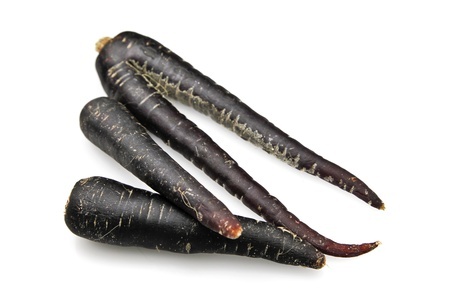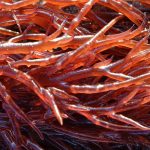
Black carrot (Daucus carota ssp. Sativus var. Atrorubens. Alef.) has an attractive blue-purple colour, an extract of which has become a popular choice for product developers looking to replace synthetics or less stable colours. The colour, due to a high level of the blue-black anthocyanins appears to have good stability to both heat, light and pH changes. These natural colours have also been found in purple corn and sweet potato (Cevallos-Casals & Cisneros-Zevallos, 2004; Bakowska-Barczak, 2005).
Black carrot as a colour ingredient is available from a number of suppliers. It used to be difficult to obtain a consistent supply because the vegetable was not widely grown except in Turkey and some other Eastern European countries. Supply meant variable cost rather than anything too consistent. The colour has been applied to beverages, jams, syrups and confectionary (Birks, 1999).
In beverages, black carrot colour imparts a strong purple –blue which can almost double for blackcurrant or black cherry but is best used in conjunction with other natural colours to impart the appropriate match. It has been used successfully to replace the synthetic food colour FD&C Red 40 (Allura Red). It can be labelled as E163 in the ingredient list but phrases such as natural colour, colour extract seem more friendly. A concentrate is also available for colouring beverages.
The Anthocyanins In Black Carrot
There are six anthocyanins with cyanidin as the aglycone (Glassgen et al., 1992). The typical derivatives include a xylosyl-galactoside and a xylosyl-glucosyl-galactoside. The latter derivative is also further monoacylated with ferulic, sinapic and p-coumaric acids (Stintzing et al., 2002; Giusti and Wrolstad, 2003). The total anthocyanin content in carrots can range from 4 mg to 17mg/kg dry matter (Kammerer et al., 2004).
The anthocyanins have been comprehensively investigated at various solid contents from 11 to 64 degree Brix (Kirca et al., 2007), from pH 4.3 to 6.0 and up to 90 °C, and storage at 4 to 37 °C. As in keeping with other anthocyanin types, the loss of colour follows a first-order reaction model. Compared to other types of anthocyanins, as pH became more alkaline, the carrot anthocyanins do not breakdown as rapidly.
It remains to explore the health-related properties of the black carrot anthocyanins. They will have antioxidant properties which gives them ubiquitous properties
References
Bakowska-Barczak, A. (2005). Acylated anthocyanins as stable, natural food colorants. Polish J. Food Nutr. Sci., 55, pp. 107–116.
Birks, S. (1999) The potential of carrots. Food-Manufacture, 47(4), pp. 22–23.
Cevallos-Casals, B.A. & Cisneros-Zevallos, L. (2004). Stability of anthocyanin-based aqueous extracts of andean purple corn and red-fleshed sweet potato compared to synthetic and natural colorants. Food Chem., 86 pp. 69–77
Giusti, M. M.; Wrolstad, R. E. (2003) Acylated anthocyanins from edible sources and their applications in food systems. Biochem. Eng. J. 14, pp. 217-225.
Glassgen, W. E., Wray, V., Dieter, S., Metzger, J. W., & Seitz, H. U. (1992). Anthocyanins from cell suspension cultures of Daucus carota. Phytochemistry, 31(5), pp. 1593–1601.
Kammerer, D., Carle, R., & Schieber, A. (2004). Quantification of anthocyanins in black carrot extracts (Daucus carota ssp. sativus var. atrorubens Alef.) and evaluation of their colour properties. Euro. Food Res. Tech., 219, pp. 479−486.
Kirca, A., Ozkan, M.; Cemeroglu, B. Effects of temperature, solid content and pH on the stability of black carrot anthocyanins. (2007) Food Chem. 101, pp. 212–218 (Article)
Stintzing, F. C.; Stintzing, A. S.; Carle, R.; Frei, B.; Wrolstad, R. E. (2002) Color and antioxidant properties of cyanidin-based anthocyanin pigments. J. Agric. Food Chem. 50, pp. 6172-6181.


Leave a Reply